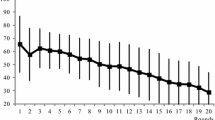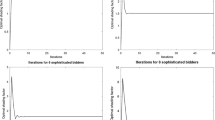Abstract
When autonomous agents decide on their bidding strategies in real world auctions, they have a number of concerns that go beyond the models that are normally analyzed in traditional auction theory. Oftentimes, the agents have budget constraints and the auctions have a reserve price, both of which restrict the bids the agents can place. In addition, their attitude need not be risk-neutral and they may have uncertainty about the value of the goods they are buying. Some of these issues have been examined individually for single-unit sealed-bid auctions. However, in this paper, we extend this analysis to the multi-unit case, and also analyze the multi-unit sealed-bid auctions in which a combination of these issues are present, for unit-demand bidders. This analysis constitutes the main contribution of this paper. We then demonstrate the usefulness in practice of this analysis; we show in simulations that taking into account all these issues allows the bidders to maximize their utility. Furthermore, using this analysis allows a seller to improve her revenue, i.e. by selecting the optimal reserve price and auction format.
Similar content being viewed by others
References
Borgs, C., Chayes, J. T., Immorlica, N., Mahdian, M., & Saber, A. (2005). Multi-unit auctions with budget-constrained bidders. In Proceedings of the 6th ACM conference on electronic commerce (ACM EC’05) (pp. 44–51).
Brandt, F., Sandholm, T., & Shoham, Y. (2007). Spiteful bidding in sealed-bid auctions. In IJCAI-07 (pp. 1207–1214).
Byde, A. (2002). Applying evolutionary game theory to auction mechanism design. HP Laboratories Bristol, Technical Report HPL-2002-321.
Che Y., Gale I. (1998) Standard auctions with financially constrained bidders. Review of Economic Studies 65(1): 1–21
Che Y. K., Gale I. (1996) Expected revenue of all-pay auctions and first-price sealed-bid auctions with budget constraints. Economics Letters 50(3): 373–379
Gerding, E. H., Dash, R. K., Yuen, D. C. K., & Jennings, N. R. (2007). Bidding optimally in concurrent second-price auctions of perfectly substitutable goods. In Proceedings of the 6th international joint conference on autonomous agents and multi-agent systems, Hawaii, USA (pp. 267–274).
Krishna V. (2002) Auction Theory. Academic Press, London
Larson, K., & Sandholm, T. (2001). Costly valuation computation in auctions. In 8th Conference of theoretical aspects of knowledge and rationality (TARK VIII) (pp. 169–182).
Lebrun B. (1999) First price auctions and the asymmetric n bidder case. International Economic Review 40(1): 125–142
Liu, Y., Goodwin R., & Koenig S. (2003). Risk-averse auction agents. In Proceedings of the 2nd international joint conference on autonomous agents and multi-agent systems (pp. 353–360).
Maskin E., Riley J. (1984) Optimal auctions with risk averse buyers. Econometrica 52(6): 1473–1518
Maskin E., Riley J. (2000) Asymmetric auctions. Review of Economic Studies 67: 413–438
Myerson R. B. (1981) Optimal auction design. Mathematics of Operations Research 6: 58–73
Parkes D. C. (1999). Optimal auction design for agents with hard valuation problems. In Proceedings of the IJCAI-99 workshop on agent mediated electronic commerce (pp. 206–219).
Rice J. A. (1995) Mathematical Statistics and Data Analysis. Duxbury Press, California
Riley J. G., Samuelson W. F. (1981) Optimal auctions. The American Economic Review 71(3): 381–392
Thompson D., & Leyton-Brown K. (2007). Valuation uncertainty and imperfect introspection in second-price auctions. In Proceedings of the 22nd conference on artificial intelligence (AAAI) (pp. 148–153).
Vetsikas, I. A., & Jennings, N. R. (2007). Outperforming the competition in multi-unit sealed bid auctions. In Proceedings of the 6th international joint conference on autonomous agents and multi-agent systems (pp. 702–709).
Vetsikas I. A., & Jennings N. R. (2008a). Bidding strategies for realistic multi-unit sealed-bid auctions. In Proceedings of AAAI-08 (pp. 182–189).
Vetsikas I. A., & Jennings N. R. (2008b). Considering assymmetric opponents in multi-unit sealed-bid auctions. In Proceedings of the 1st international workshop on market based control (MBC).
Weber R. (1997) Making more from less: Strategic demand reduction in the fcc spectrum auctions. Journal of Economics and Management Strategy 6(3): 529–548
Author information
Authors and Affiliations
Corresponding author
Rights and permissions
About this article
Cite this article
Vetsikas, I.A., Jennings, N.R. Bidding strategies for realistic multi-unit sealed-bid auctions. Auton Agent Multi-Agent Syst 21, 265–291 (2010). https://doi.org/10.1007/s10458-009-9109-6
Published:
Issue Date:
DOI: https://doi.org/10.1007/s10458-009-9109-6




